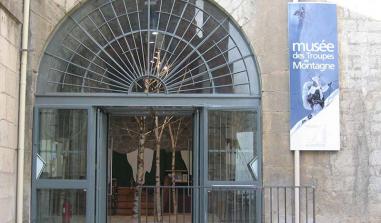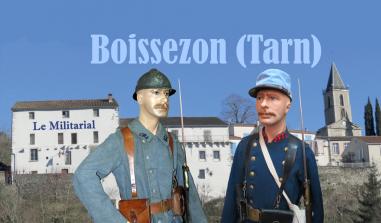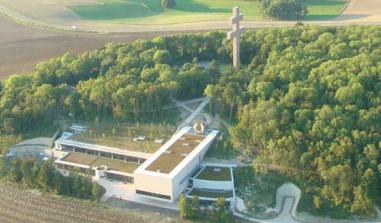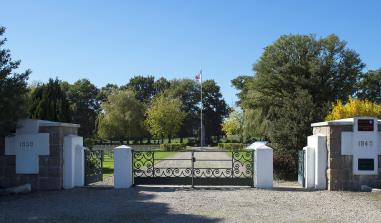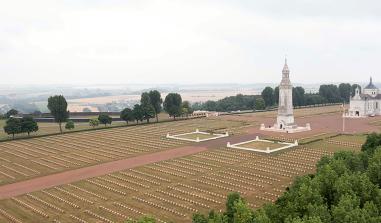The national day of the deportation
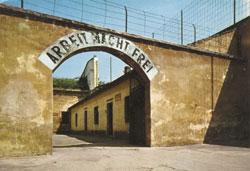
One of the mottos inscribed at the entrance to the camps "work brings freedom". Source: SGA/DMPA Collection
Corps 1
A few years after the end of the Second World War (1939-45), the French Republic decided to honour the memory of the victims of the deportation and, in particular, those deported from France to Nazi concentration or extermination camps. Since the application of the law of 14 April 1954, the last Sunday in April is designated "National Day for remembering the victims and heroes of the deportation".
Corps 2
(1939-45)
As soon as they arrived in power in January 1933, Adolf Hitler and the Nazis created the first concentration camps in Germany. Dachau was thus opened on 21 March 1933. Interned here were the opponents of the regime, the "social misfits" and all those who did not conform to the national-socialist norms. With German expansion in Europe and then the Second World War, the Concentration camp system took on a whole new dimension. From 1941 onwards, it also became incorporated into the establishment of the "final solution to the Jewish question". The number of camps multiplied, including in annexed or occupied territories: Mauthausen in Austria, Auschwitz in Poland, Natzweiler (Struthof) in France etc.
The number of deportees from France to the Nazi concentration and extermination camps during the Second World War is estimated to be more than 150,000 people, including 80,000 victims of measures of repression (mainly political activists and resistance fighters) and 75,000 Jews, the victims of persecution measures also affecting Gypsies. In total, more than 100,000 deportees from France died. With the liberation of the camps and then the return of the first survivors, the whole world was able to assess the amplitude and horror of the deportation.
The need to preserve the memory of the deportation is sanctioned by the law of 14 April 1954
To keep alive the memory of their comrades who died during the deportation, the deportees associations have created places of remembrance, such as, in Paris, the memorial monument at the synagogue in rue de la Victoire (inaugurated on 27 February 1949) and the chapel of the deportees in the church of Saint-Roch (opened on 21 November 1953), around which they organise specific commemorations. Additionally, delegations of former deportees stand beside ex-servicemen at the official ceremonies to commemorate the First and Second World Wars. Since the beginning of the 1950's, former deportees and families of those who died have expressed their wish to see the allocation of a date in the calendar of national commemorations to remembrance of the deportation. The choice of the last Sunday in April was made because of its proximity to the anniversary of the liberation of most of the camps, without the risk of it becoming confused with any existing national or religious holiday or celebration.
Law no. 54-415 of 14 April 1954 This law dedicates the last Sunday in April to remembrance of the victims of the deportation and those who died in the concentration camps of the Third Reich during the 1939-1945 war. It was voted in unanimously by Parliament, thus making this Sunday a day of national celebration: "Article 1: The French Republic will celebrate annually, on the last Sunday in April, the commemoration of the heroes and victims of the deportation to concentration camps during the 1939-1945 war. Article 2: The last Sunday in April shall become "The National Day of remembrance for the victims and heroes of the deportation". Official ceremonies will mark the memory of the suffering and torture sustained by the deportees in the concentration camps and will pay homage to the courage and heroism of those men and women who became victims of it." For its instigators, the national day of the deportation responds to two demands. First of all, it reminds everyone of this major episode in history, as well as the lessons that came out of it. According to the wording of the report on the reasons for the law, in order that such events do not happen again, "it is important not to let the memories and lessons of such an experience be forgotten; neither the atrocious and scientific extermination of millions of innocent people, nor the heroic acts of a great number amongst this mass of people, subjected to torture of starvation, cold, vermin, exhausting work and sadistic reprisals, any more than the deliberate cruelty of the torturers." Secondly, through this celebration, the nation can honour the memory of all deportees - including those victims of the deportations in Indochina as a result of Japanese imperialism - survivors and the dead, in order to pay homage to their sacrifice.
The format of the commemoration has evolved since 1954 From its creation to modern day, the format of the commemoration of the national day of the deportation has undergone many modifications. In each département, its organisation falls to the prefect in conjunction with the various associations. Steles plaques and monuments are decorated with flowers; speeches are read out and teachers are also generally invited to use the occasion to teach students about the deportation and concentration camp system.
In Paris, the national day of the deportation has evolved according to the successive emergence of three new remembrance sites: the memorial of the unknown Jewish martyr on rue Geoffroy l'Asnier, in the 4th arrondissement (inaugurated on 30 October 1956), the memorial of Fighting France at Mont-Valérien in Suresnes (inaugurated in its current form on 18 June 1960) and the memorial of the martyrs of the deportation on the l'Île de la Cité which keeps alive the memory of all French deportees (inaugurated on 12 April 1962). Nowadays the ceremony is divided into three parts, following a pattern instigated in 1985 and 1988. Homage is first paid at the memorial of the unknown Jewish martyr and then at the memorial for the martyrs of the deportation. The commemoration ends with the relighting of the flame at the Arc de Triomphe. In order to keep the memory of the deportation alive for the younger generations, poems are read by teenagers at the memorial of the martyrs of the deportation.
The Song of the marshes Any directions you might see, Bog and heath is everywhere. Here are no birds to sing for me The oaks, they stand twisted and bare. We are the bog battalion, On spade instead of stallion, In bog. In such a deserted landscape Just for us, this compound dire. Far from friends and with no escape We are cached behind barb-ed wire. We are the bog battalion, On spade instead of stallion, In bog. The patrols guard us day and night, Escape is a losing sport. Your life's not worth attempted flight, Four rings of wire fence the fort. We are the bog battalion, On spade instead of stallion, In bog. Complaining will not set us free; Winter can't last forever. The time will come when we will see, Our homeland ours, together. Then no more bog battalion No spade instead of stallion In Bog. * Composed in 1934 by German political detainees in the camp of Börgermoor (the "camp in the marshes"), after the Second World War this song became the commemorative hymn of all former deportees.
As soon as they arrived in power in January 1933, Adolf Hitler and the Nazis created the first concentration camps in Germany. Dachau was thus opened on 21 March 1933. Interned here were the opponents of the regime, the "social misfits" and all those who did not conform to the national-socialist norms. With German expansion in Europe and then the Second World War, the Concentration camp system took on a whole new dimension. From 1941 onwards, it also became incorporated into the establishment of the "final solution to the Jewish question". The number of camps multiplied, including in annexed or occupied territories: Mauthausen in Austria, Auschwitz in Poland, Natzweiler (Struthof) in France etc.
The number of deportees from France to the Nazi concentration and extermination camps during the Second World War is estimated to be more than 150,000 people, including 80,000 victims of measures of repression (mainly political activists and resistance fighters) and 75,000 Jews, the victims of persecution measures also affecting Gypsies. In total, more than 100,000 deportees from France died. With the liberation of the camps and then the return of the first survivors, the whole world was able to assess the amplitude and horror of the deportation.
The need to preserve the memory of the deportation is sanctioned by the law of 14 April 1954
To keep alive the memory of their comrades who died during the deportation, the deportees associations have created places of remembrance, such as, in Paris, the memorial monument at the synagogue in rue de la Victoire (inaugurated on 27 February 1949) and the chapel of the deportees in the church of Saint-Roch (opened on 21 November 1953), around which they organise specific commemorations. Additionally, delegations of former deportees stand beside ex-servicemen at the official ceremonies to commemorate the First and Second World Wars. Since the beginning of the 1950's, former deportees and families of those who died have expressed their wish to see the allocation of a date in the calendar of national commemorations to remembrance of the deportation. The choice of the last Sunday in April was made because of its proximity to the anniversary of the liberation of most of the camps, without the risk of it becoming confused with any existing national or religious holiday or celebration.
Law no. 54-415 of 14 April 1954 This law dedicates the last Sunday in April to remembrance of the victims of the deportation and those who died in the concentration camps of the Third Reich during the 1939-1945 war. It was voted in unanimously by Parliament, thus making this Sunday a day of national celebration: "Article 1: The French Republic will celebrate annually, on the last Sunday in April, the commemoration of the heroes and victims of the deportation to concentration camps during the 1939-1945 war. Article 2: The last Sunday in April shall become "The National Day of remembrance for the victims and heroes of the deportation". Official ceremonies will mark the memory of the suffering and torture sustained by the deportees in the concentration camps and will pay homage to the courage and heroism of those men and women who became victims of it." For its instigators, the national day of the deportation responds to two demands. First of all, it reminds everyone of this major episode in history, as well as the lessons that came out of it. According to the wording of the report on the reasons for the law, in order that such events do not happen again, "it is important not to let the memories and lessons of such an experience be forgotten; neither the atrocious and scientific extermination of millions of innocent people, nor the heroic acts of a great number amongst this mass of people, subjected to torture of starvation, cold, vermin, exhausting work and sadistic reprisals, any more than the deliberate cruelty of the torturers." Secondly, through this celebration, the nation can honour the memory of all deportees - including those victims of the deportations in Indochina as a result of Japanese imperialism - survivors and the dead, in order to pay homage to their sacrifice.
The format of the commemoration has evolved since 1954 From its creation to modern day, the format of the commemoration of the national day of the deportation has undergone many modifications. In each département, its organisation falls to the prefect in conjunction with the various associations. Steles plaques and monuments are decorated with flowers; speeches are read out and teachers are also generally invited to use the occasion to teach students about the deportation and concentration camp system.
In Paris, the national day of the deportation has evolved according to the successive emergence of three new remembrance sites: the memorial of the unknown Jewish martyr on rue Geoffroy l'Asnier, in the 4th arrondissement (inaugurated on 30 October 1956), the memorial of Fighting France at Mont-Valérien in Suresnes (inaugurated in its current form on 18 June 1960) and the memorial of the martyrs of the deportation on the l'Île de la Cité which keeps alive the memory of all French deportees (inaugurated on 12 April 1962). Nowadays the ceremony is divided into three parts, following a pattern instigated in 1985 and 1988. Homage is first paid at the memorial of the unknown Jewish martyr and then at the memorial for the martyrs of the deportation. The commemoration ends with the relighting of the flame at the Arc de Triomphe. In order to keep the memory of the deportation alive for the younger generations, poems are read by teenagers at the memorial of the martyrs of the deportation.
The Song of the marshes Any directions you might see, Bog and heath is everywhere. Here are no birds to sing for me The oaks, they stand twisted and bare. We are the bog battalion, On spade instead of stallion, In bog. In such a deserted landscape Just for us, this compound dire. Far from friends and with no escape We are cached behind barb-ed wire. We are the bog battalion, On spade instead of stallion, In bog. The patrols guard us day and night, Escape is a losing sport. Your life's not worth attempted flight, Four rings of wire fence the fort. We are the bog battalion, On spade instead of stallion, In bog. Complaining will not set us free; Winter can't last forever. The time will come when we will see, Our homeland ours, together. Then no more bog battalion No spade instead of stallion In Bog. * Composed in 1934 by German political detainees in the camp of Börgermoor (the "camp in the marshes"), after the Second World War this song became the commemorative hymn of all former deportees.
Sources
Source : Collection "Mémoire et citoyenneté", N° 18. Publication Ministère de la défense/SGA/DMPA


